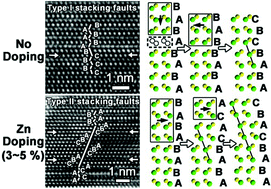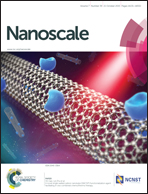Zn-dopant dependent defect evolution in GaN nanowires†
Abstract
Zn doped GaN nanowires with different doping levels (0, <1 at%, and 3–5 at%) have been synthesized through a chemical vapor deposition (CVD) process. The effect of Zn doping on the defect evolution, including stacking fault, dislocation, twin boundary and phase boundary, has been systematically investigated by transmission electron microscopy and first-principles calculations. Undoped GaN nanowires show a hexagonal wurtzite (WZ) structure with good crystallinity. Several kinds of twin boundaries, including (10![[1 with combining macron]](https://www.rsc.org/images/entities/char_0031_0304.gif) 3), (10
3), (10![[1 with combining macron]](https://www.rsc.org/images/entities/char_0031_0304.gif) 1) and (20
1) and (20![[2 with combining macron]](https://www.rsc.org/images/entities/char_0032_0304.gif) 1), as well as Type I stacking faults (…ABAB
1), as well as Type I stacking faults (…ABAB![[C with combining low line]](https://www.rsc.org/images/entities/b_char_0043_0332.gif) BCB…), are observed in the nanowires. The increasing Zn doping level (<1 at%) induces the formation of screw dislocations featuring a predominant screw component along the radial direction of the GaN nanowires. At high Zn doping level (3–5 at%), meta-stable cubic zinc blende (ZB) domains are generated in the WZ GaN nanowires. The WZ/ZB phase boundary (…ABABA
BCB…), are observed in the nanowires. The increasing Zn doping level (<1 at%) induces the formation of screw dislocations featuring a predominant screw component along the radial direction of the GaN nanowires. At high Zn doping level (3–5 at%), meta-stable cubic zinc blende (ZB) domains are generated in the WZ GaN nanowires. The WZ/ZB phase boundary (…ABABA![[C with combining low line]](https://www.rsc.org/images/entities/b_char_0043_0332.gif) BA…) can be identified as Type II stacking faults. The density of stacking faults (both Type I and Type II) increases with increasing the Zn doping levels, which in turn leads to a rough-surface morphology in the GaN nanowires. First-principles calculations reveal that Zn doping will reduce the formation energy of both Type I and Type II stacking faults, favoring their nucleation in GaN nanowires. An understanding of the effect of Zn doping on the defect evolution provides an important method to control the microstructure and the electrical properties of p-type GaN nanowires.
BA…) can be identified as Type II stacking faults. The density of stacking faults (both Type I and Type II) increases with increasing the Zn doping levels, which in turn leads to a rough-surface morphology in the GaN nanowires. First-principles calculations reveal that Zn doping will reduce the formation energy of both Type I and Type II stacking faults, favoring their nucleation in GaN nanowires. An understanding of the effect of Zn doping on the defect evolution provides an important method to control the microstructure and the electrical properties of p-type GaN nanowires.



 Please wait while we load your content...
Please wait while we load your content...